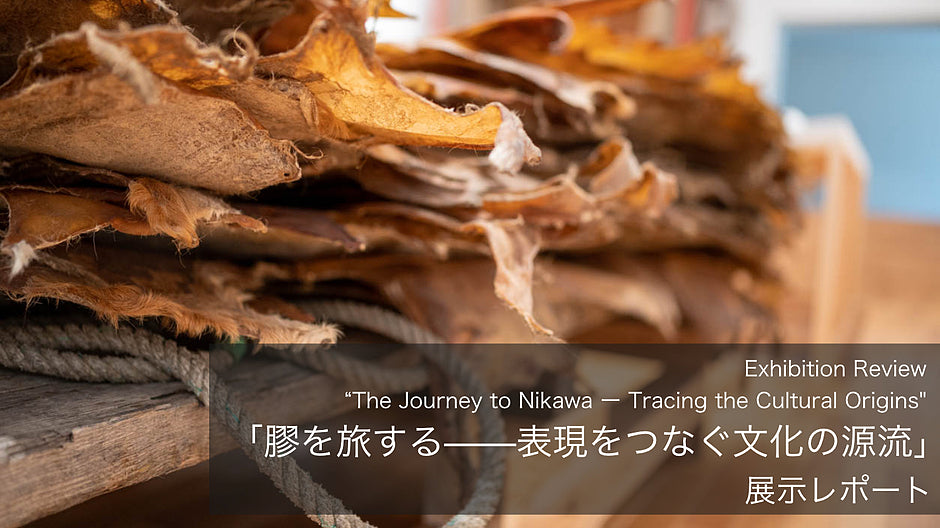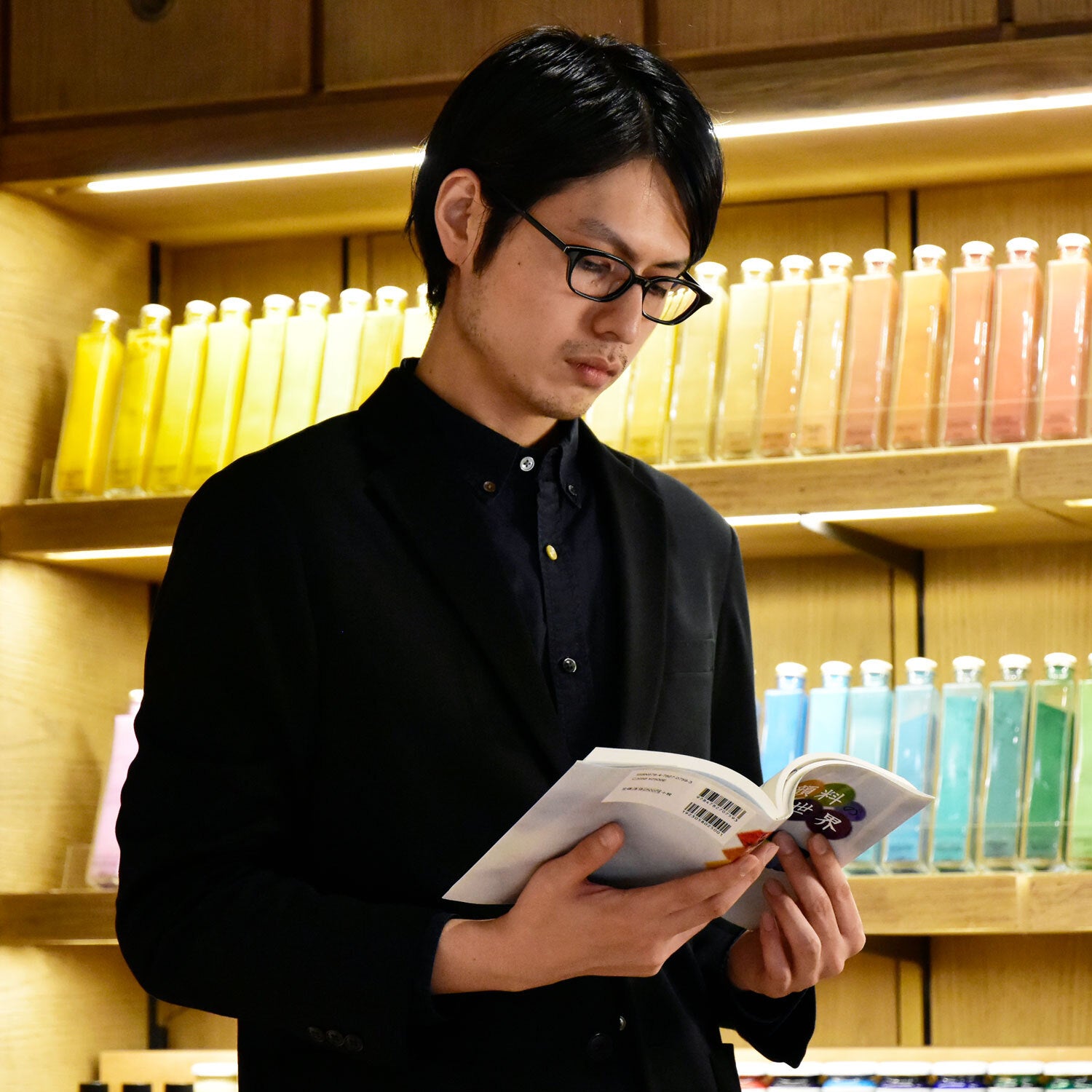Nikawa (or animal glue) is a binder made by boiling the skins and bones of animals, such as deer and fish, to liquid and then cooling them down to a gelatin form before drying them for easier storage.
When using Nikawa, you have to soak it in water and cook it until it turns back to the liquid with usable viscosity and adhesiveness. In Nihonga (Japanese painting), Nikawa is mainly used as an adhesive to apply pigments on the Washi paper; and in oil or tempera painting, it is commonly used as a binder to knead with gesso plaster for undercoating.
As there is a saying in Japanese, “膠漆の交わり (Koushitsu no Majiwari, animal glue and lacquer bond with each other)” which means an intimate/close relationship that is hard to separate or what we called “hand and glove” in English.
Therefore, the use of animal glue has an inseparable relationship with art history which traces back to the Dordogne in France 20,000 years ago. The Cro-Magnons, the first early modern humans (Homo sapiens), left wall paintings in caves using animal blood, fats, and vegetable resin.
Although it would be an anecdote to say that blood, fats, and resin are equivalent to animal glue in modern days, the world's earliest binder for paintings is certainly made of animal proteins.
Besides, even for now, animal glue isn’t only used as a painting medium.
For example, in Japan, Nikawa is used not only for painting but also as an adhesive.
According to the first edition of Nihon Bijutsu Jiten (or Dictionary of Japanese Fine Arts) published in 1952, describes Nikawa as “an adhesive for woodworking and as a painting medium in Asian art ”.
Today, with the rise of synthetic resin adhesives and wood glue, it isn’t a common idea of linking animal glue to adhesives, but it’s surprising to see how an art dictionary mentions Nikawa’s role as an adhesive before its use in painting.
For three years starting in 2017, Musashino Art University conducted a joint research project called "日本画の伝統素材『膠』に関する調査研究 (Research and Study on Nikawa, a Traditional Material for Japanese Painting)," which focuses on field surveys and researching with painters and scholars.
An exhibition that can be called “the culmination of the research results” will be held at the Musashino Art University Museum & Library from May 12th to June 20th, 2021.
“The Journey to Nikawa ー Tracing the Cultural Origins”, the exhibition is held in two different exhibition rooms supervised by emeritus professor of MAU, Aguri Uchida.
It isn’t just a final presentation of research results and materials, but also an aesthetic show through installation.
Therefore, the "journey" begins.

Along with pictures and videos that were taken by photographer Ali Uchida, who has accompanied the whole research study, the exhibition includes authentic materials such as various types of animal glues, raw materials like cow and deer skins, and the actual tools that were used by the manufacturer.
The first section displays art materials from painters' studios which include several kinds of Nikawa that are used in their paintings, as well as Iwaenogu (mineral pigments) palettes, original paintings, and studies of Takashi Asada from 35 years ago.

As you can see from the picture above, there are many kinds of Nikawa , including those derived from cows, deer, and even fish.

These are some of the art materials from Takashi Asada's studio. Although he passed away in 1987, the traces of his fingers kneading the pigments with animal glue still remain on the color palettes.

This is a collage by combining the fragments of Aguri Uchida’s work.
From this collage of works, you can tell that it’s possible to create several kinds of texture by painting with rough mineral pigments and Sumi ink on Kozogami (a type of Washi paper made of a mulberry plant) and sewing them on Kumohadamashi (another type of Washi paper made of hemp and mulberry plants)with the paper strings.
In this exhibition, you can learn how Nikawa is used as a painting medium without discoloring the mineral pigments and being able to firmly fix them on the Washi paper.
As you keep going, there’s a section where you will get to see the raw materials of animal glue in various shapes and sizes, which aren’t usually disclosed.

Tomoyo Ono (right), a curator of MAU Museum & Library, explains the concept of this exhibition in front of a large pile of dried cowhides.

A huge cowhide stretched in a drying wooden frame.
The wooden frame is covered with countless nail marks from stretching the skins and hides.

Dried deer skins hanging from the ceiling.
This exhibition is not only exploring Nikawa from a material scientific perspective but also a journey to trace its ethnographical roots.
For example, works that are made of fish skins by the Nanai tribe (a northern ethnic minority living in Russia and China), and shoes made of salmon skins by the Ainu people are displayed and shown in this exhibition.
Therefore, visitors can learn how deeply leather and hide culture was connected to daily life in the past.

《Shaman’s Dress》by A.P. Donkan, 1998, property of Bunka Gakuen Costume Museum
In this exhibition, you will also get to have a look at works, such as fish skin garments made by Nanai artist A.P. Donkan. These garments are decorated with traditional ornaments and patterns while adopting a touch of modern design.

《Cep-keri》 property of The Foundation for Ainu Culture
(※P and Ri are written in Sutegana*)
* Sutegana Japanese small Okurigana used with Kanbun or small kana used for diphthongs
These shoes are made by processing salmon skin. Instead of tanning them, the dried salmon skin is soaked in water or lukewarm water to tenderize it, and then sewn with plant-based thread.
Moreover, the exhibition also featured the paintings collection of MAU Museum & Library as an example of the use of Nikawa.

《The Hiroshima Panels, Takahari Chouchin》(left) by Iri and Toshi Maruki, 1986, property of Musashino Art University Museum & Library
《Cowshed》(right) by Takashi Asada, 1952, property of Musashino Art University Museum & Library
Above all, the work《The Hiroshima Panels, Takahari Chouchin》by Iri and Toshi Maruki were donated as a result of this joint research to the MAU Museum & Library in 2020 when the Osaka Human Rights Museum was relocated.
To accommodate this exhibition, the minor cracks in the painting were fixed by using Nikawa.
This work perfectly demonstrates the various roles that Nikawa brings to Japanese painting - it is not only one of the eye-catching art materials in this exhibition, a unique connection with the Osaka Human Rights Museum but also a reversible adhesive, which answers everyone’s wondering and curiosity about Nikawa.

《The Hiroshima Panels, Takahari Chouchin》(partial) by Iri and Toshi Maruki, 1986, property of Musashino Art University Museum & Library
Perhaps, this will be the “last station” of our journey to Nikawa.
According to《Zenyaku Kanjikai (3rd Edition)》(「全訳漢辞海(第三版)」) by Books Sanseido, the Kanji character for a journey, “旅, tabi” which also included the meaning of “together, along with”.
Therefore, "The Journey to Nikawa" was not only a pilgrimage to overlook the state of the medium in Japan, but also a tale that connects the past and present, and how we have been living "together" with animals.
With the changing times and the fading of the leather industry, the continuity of Nikawa is in jeopardy.
However, as long as we take these techniques as our proud heritage and continue the path of this journey by holding hands together, this culture will surely last forever.
Exhibition Info.
「The Journey to Nikawa ー Tracing the Cultural Origins」
Advisor: Aguri Uchida (Emeritus professor of Musashino Art University)
Place: Musashino Art University Museum & Library
Venue: Gallery 4・5
Date: May 12 (Wed) - June 20 (Sun) 2021
Time: 12:00 - 18:00 (Closes at 17:00 on Saturdays, National Holidays, and Special Opening Days)
Closed: Sundays ※June 13 and 20 will be Special Opening Days
URL:https://mauml.musabi.ac.jp/museum/en/events/17300/
※Starting June 5, MAU M&L will reopen to the public on Saturdays and Sundays only, reservation is required. Check the official website for more information.
*This exhibition has ended.

Reference
「The Journey to Nikawa」by Aguri Uchida (Kokushokankokai Inc., 2021)
Format: B5 size
ISBN:978-4-336-07184-2
Number of pages: 240
Written and photographed by Akira Oya
Translated by Atsumi Okano, Nelson Hor Ee Herng
PIGMENT TOKYO Art Materials Expert



